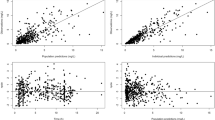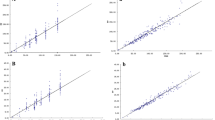Abstract
Objective
To evaluate the dosage regimens of ciprofloxacin prescribed for outpatients by applying the principles of antibacterial therapy.
Design
Retrospective analysis of prescription and demographic data.
Setting
Community pharmacy in Valladolid, Spain.
Patients
Fifty male and female patients aged 18–93 years and with bodyweight 41–95kg.
Methods
Prescribed dosage regimen, age, weight, height, type of infection, comorbidity and coadministered drugs were recorded for each patient. Plasma concentration curves were simulated from literature values of the pharmacokinetic parameters of the drug and the age and weight of the patients. Urine concentrations were estimated from simulated plasma concentrations, literature values of renal clearance and an average urinary flow rate of 2 L/day. The potential efficacy of the prescribed treatment was evaluated from the ratio of the simulated peak plasma concentration (Cmax) to the literature value of the minimum inhibitory concentration (MIC) for the bacterium most probably responsible for the infection (Cmax/MIC). The ratio of area under the plasma concentration-time curve over 24 hours to MIC (AUC24/MIC) was also estimated for non-urinary infections.
Results
Demographic variables such as age or bodyweight do not seem to be taken in consideration when ciprofloxacin is prescribed, at least in the patients considered here, leading to wide interindividual variability in plasma concentrations. This may not be relevant for urinary infections, since ciprofloxacin concentrates in the urine, leading to high Cmax/MIC ratios in all patients. Simulated plasma concentration-time curves revealed consistent underdosing for systemic infections in young patients over 60kg, for whom the plasma concentrations achieved led to Cmax/MIC and AUC24/MIC ratios lower than those associated with clinical efficacy and minimal spread of bacterial resistance.
Conclusions
The standard regimen of ciprofloxacin 250mg every 12 hours prescribed for urinary infections may not be the best choice, since a more convenient regimen of 500mg once daily leads to a higher Cmax/MIC ratio, which is associated with a more significant postantibiotic effect and higher efficacy of fluoroquinolones. For non-urinary infections, the age and weight of patients should be taken into account to achieve optimum plasma concentrations.






Similar content being viewed by others
References
Levy SB. Antibiotic availability and use: consequences to man and his environment. J Clin Epidemiol 1991; 44 Suppl. II: S83–7
Baquero F, Martínez Beltrán J, Loza E. A review of antibiotic resistance patterns of Streptococcus pneumoniae in Europe. J Antimicrob Chemother 1991; 28 Suppl. C: 31–8
Ruiz Bremon A, Ruiz-Tovar M, Perez Gorricho B, et al. Non-hospital consumption of antibiotics in Spain: 1987–1997. J Antimicrob Chemother 2000; 45: 395–400
Schentag JJ, Ballow CH, Paldino JA, et al. Dual individualization with antibiotics: integrated antibiotic management strategies for use in hospitals. In: Evans WE, Schentag JJ, Jusko WJ, editors. Applied pharmacokinetics. 3rd ed. Vancouver (WA): Applied Therapeutics Inc., 1992; 17: 1–20
Bouvier D’Ivoire MIJ, Mire PH. Dosage regimens of antibacterials: implications of a pharmacokinetic/pharmacodynamic model. Clin Drug Invest 1996; 11: 229–39
Craig WA. Pharmacokinetic/pharmacodynamic parameters: rationale for antibacterial dosing of mice and men. Clin Infect Dis 1998; 26: 1–10
Li RC, Zhu M, Schentag JJ. Achieving an optimal outcome in the treatment of infections: the role of clinical pharmacokinetics and pharmacodynamics of antimicrobials. Clin Pharmacokinet 1999; 37: 1–16
Baquero F. Antibiotic resistance in Spain: what can be done?. Task force of the General Directorate for Health Planning of the Spanish Ministry of Health. Clin Infect Dis 1996; 23: 819–23
Doern GV. Trends in antimicrobial susceptibility of bacterial pathogens of the respiratory tract. Am J Med 1995; 99 Suppl. 6B: S3–7
Jalal S, Ciofu O, Hoiby N, et al. Molecular mechanisms of fluoroquinolone resistance in Pseudomonas aeruginosa isolates from cystic fibrosis patients. Antimicrob Agents Chemother 2000; 44(3): 710–2
Goettsch W, van Pelt W, Nagelkerke N, et al. Increasing resistance to fluoroquinolones in Escherichia coli from urinary tract infections in the Netherlands. J Antimicrob Chemother 2000; 46(2): 223–8
Yamaguchi K, Miyazaki S, Kashitani F, et al. Activities of antimicrobial agents against 5180 clinical isolates obtained from 26 medical institutions during 1998 in Japan. Levofloxacin. Jpn J Antibiot 2000; 53(6): 387–408
Wolfson JS, Hooper DC. The fluoroquinolones: structures, mechanisms of action and spectra of activity in vitro. Anti-microb Agents Chemother 1985; 28(4): 581–6
Campoli-Richards DM, Monk JP, Price A, et al. Ciprofloxacin: a review of its antibacterial activity, pharmacokinetic properties and therapeutic use. Drugs 1988; 35: 373–447
Grump B, Wise R, Dent J. Pharmacokinetics and tissue penetration of ciprofloxacin. Antimicrob Agents Chemother 1983; 24(5): 784–6
González MA, Uribe F, Moisen SD, et al. Multiple dose pharmacokinetics and safety of ciprofloxacin in normal volunteers. Antimicrob Agents Chemother 1984; 26: 741–4
Fung-Tomc J, Minassian B, Kolek B, et al. In vitro antibacterial spectrum of a new broad-spectrum 8-methoxy fluoroquinolone, gatifloxacin. J Antimicrob Chemother 2000; 45: 437–46
Aminimanizani A, Beringer P, Jelliffe R. Comparative pharmacokinetics and pharmacodynamics of the newer fluoroquinolone antibacterials. Clin Pharmacokinet 2001; 40(3): 169–87
Sánchez-Navarro A, Sánchez Recio MM. Basis of anti-infective therapy: pharmacokinetic-pharmacodynamic criteria and methodology for dual dosage individualisation. Clin Pharmacokinet 1999; 37: 289–304
MacGowan A, Rogers C, Bowker K. The use of in vitro pharmacodynamic models of infection to optimize fluoroquinolones dosing regimens. J Antimicrob Chemother 2000; 46: 163–70
Sanchez-Recio MM, Colino CI, Sanchez-Navarro A. A retrospective analysis of pharmacokinetic/pharmacodynamic indices as indicators of the clinical efficacy of ciprofloxacin. J Antimicrob Chemother 2000; 45: 321–8
Sánchez-Navarro A, Colino CI, Sánchez Recio MM. A retrospective analysis of pharmacokinetic-pharmacodynamic parameters as indicators of the clinical efficacy of ceftizoxime. Clin Pharmacokinet 2001; 40(2): 125–34
Hyatt JM, Nix DE, Schentag JJ. Pharmacokinetic and pharmacodynamic activities of ciprofloxacin against strains of Streptococcus pneumoniae, Staphylococcus aureus and Pseudomonas aeruginosa for which MICs are similar. Anti-microb Agents Chemother 1994; 32(12): 2730–7
Hyatt JM, Mckinnon PS, Zimmer GS, et al. The importance of pharmacokinetic/pharmacodynamic surrogate markers to outcome. Clin Pharmacokinet 1995; 28: 143–60
Forrest A, Chodosh S, Amantea MA, et al. Pharmacokinetics and pharmacodynamics of oral grepafloxacin in patients with acute bacterial exacerbations of chronic bronchitis. J Antimicrob Chemother 1997; 40 Suppl. A: 45–57
Wagner JG. Farmacocinética clínica. Barcelona: Reverté SA, 1983: 129–74
LeBel M, Barbeau G, Bergeron MG, et al. Pharmacokinetics of ciprofloxacin in elderly subjects. Pharmacotherapy 1986; 6(2): 87–91
AbbottBase pharmacokinetic system. Abbott Park (IL): Abbott Laboratories, Diagnostic Division, 1991
Sánchez Navarro MD, Sayalero Marinero ML, Sánchez Navarro A. Pharmacokinetic/pharmacodynamic modelling of ciprofloxacin 250mg/12 versus 500mg/24h. J Antimicrob Chemother 2002; 50: 67–72
Davis R, Markham A, Balfour J. Ciprofloxacin: an updated review of it pharmacology, therapeutic efficacy and tolerability. Drugs 1996; 51: 1019–74
Forrest A, Ballow C, Nix D, et al. Development of a population pharmacokinetic model and optimal sampling strategies for intravenous ciprofloxacin. Antimicrob Agents Chemother 1993; 37: 1065–72
Jelliffe R, Schumtzky A, Bayard D, et al. Model-based, goal-oriented, individualised drug therapy: linkage of population modelling, new ‘multiple model’ dosage design, Bayesian feedback and individualised target goals. Clin Pharmacokinet 1998; 34: 57–77
Acknowledgements
The authors would like to thank the patients involved in the study for their collaboration. This study was supported by the University of Salamanca, Spain.
Author information
Authors and Affiliations
Corresponding author
Rights and permissions
About this article
Cite this article
Navarro, M.D.S., Milano, C.C., Castañeda, A.Z. et al. Pharmacokinetics of Ciprofloxacin as a Tool to Optimise Dosage Schedules in Community Patients. Clin Pharmacokinet 41, 1213–1220 (2002). https://doi.org/10.2165/00003088-200241140-00005
Published:
Issue Date:
DOI: https://doi.org/10.2165/00003088-200241140-00005




